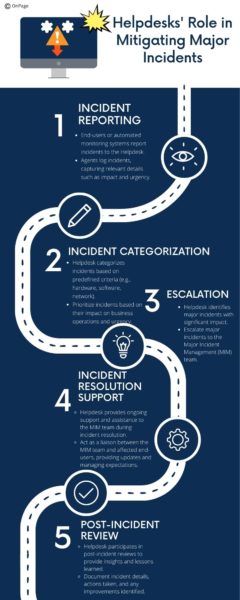How Helpdesks Facilitate Major Incident Management

Helpdesks serve as the initial line of defense for IT incidents, responsible for facilitating incident management, including logging, categorizing, and prioritizing incidents. In the event of a major incident, the helpdesk plays a crucial role in escalating the incident to the appropriate major incident management (MIM) team.
The success of this process relies on the expertise of the helpdesk staff in providing situational context to expedite resolution. If the helpdesk escalates an incident to their MIM team without providing any information about the event, the MIM team may experience delays in sending out communication and engaging the right tech experts.
This blog will outline the steps involved in major incident management and highlight the vital role that helpdesk agents play in facilitating the process. We will also delve into the working dynamics between the helpdesk agents and the major incident management (MIM) team.
Major Incident Management Process
The major incident management process begins with the helpdesk identifying that a major incident has occurred, which refers to an incident with a significant impact on business operations. For example, a major incident could be a widespread network outage affecting multiple departments or a security breach compromising sensitive data. Once identified, the helpdesk staff logs it on their helpdesk software and escalates the incident to the MIM team, who then mobilizes the necessary technology groups to address the incident promptly.
Let’s consider an example: A major incident occurs when a critical server experiences a hardware failure, resulting in a complete service disruption for an organization. The service desk receives multiple user reports and immediately recognizes the severity and impact of the incident. They promptly escalate the incident to the MIM team, providing detailed information about the affected server, its criticality, and the potential business consequences.
In a distributed work environment where teams are not physically co-located, communicating critical information can pose challenges. To address this issue, companies may deploy incident alert management tools in such cases to promptly deliver critical alerts informing of an outage.
Try OnPage for FREE! Request an enterprise free trial.
Once MIM teams have access to valuable information at their disposal, they swiftly organize a highly capable cross-functional unit comprising proficient server administrators, adept network engineers, and skilled database administrators. Together, they engage in seamless collaboration to accurately identify and diagnose the underlying problem. Simultaneously, they efficiently coordinate the procurement of suitable replacement hardware, ensuring the swift restoration of the server’s optimal functionality.
Recognizing the importance of risk management and business continuity, the company’s preparedness measures may also come into play. In the event that the aforementioned hardware is deemed to have a high-risk quotient, the team may have a backup readily accessible. This foresight enables them to seamlessly implement the necessary measures for a smooth transition and ensures minimal disruption to critical operations.
Throughout the resolution process, the service desk maintains open communication with the affected users, providing regular updates on the progress and estimated resolution time. They may deploy mass notification tools to broadcast updates from time to time via email, text and voice.
Four Steps of Major Incident Management
The previously mentioned example can be condensed down into four essential steps. In essence, the major incident management process broadly involves four steps aimed at swiftly addressing and resolving significant incidents that have a significant impact on business operations. Here, we outline the four key steps within the major incident management process:
- Identification
- Escalation
- Resolution
- Recovery
Identification: The first step in major incident management is to identify that a major incident has occurred. A major incident is defined as an incident that has a significant impact on business operations.
Escalation: Once a major incident has been identified, the service desk will escalate the incident to the appropriate teams and begin working on a resolution. To carry out this step more effectively and reliably, they may implement an alert management tool to promptly capture the right team member’s attention.
Resolution: The goal of major incident management is to minimize the impact of incidents on business operations and to restore normal service operations as quickly as possible. To do this, the helpdesk will work with the appropriate teams to resolve the issue and restore normal service operation.
Recovery: Once normal service operation has been restored, the helpdesk will work with the affected teams to ensure that all systems are functioning properly and that there are no residual effects from the major incident.

Helpdesks and Major Incident Team Dynamics
As previously mentioned, within the context of major incident management, the helpdesk acts as the starting point for any MIM process. Whether triggered by a call from an end-user or a major impact on a critical service, the helpdesk is responsible for recognizing incidents that could be pre-indicators of larger issues.
The service desk plays a critical role in deciding whether an issue requires escalation and provides essential context to the MIM team. In cases where incidents are not promptly reported to the MIM team in a timely manner, or with sufficient information, it is essential for MIM teams to reflect on their training and ongoing support provided to the helpdesk, rather than engaging in a blame game. By acknowledging helpdesks as valued team members and extension of the MIM team, organizations foster a collaborative environment where everyone takes collective responsibility for incident resolution.
Now, let’s examine two examples that exemplify successful collaboration between these two entities:
Example 1: Let’s imagine an organization’s website experiences a major outage, preventing customers from accessing online services. An internal employee contacts the helpdesk, reporting the issue and highlighting the significant impact on customer experience and revenue generation. The helpdesk agent recognizes the severity of the incident and immediately escalates it to the MIM team, emphasizing the urgency and providing key details regarding the affected service and its criticality to the organization’s revenue.
The collaboration between the service desk and the MIM team is vital for efficient incident resolution. Helpdesk agents need to promptly escalate major incidents, ensuring the MIM team has all the relevant details and context necessary for effective action. Clear and concise communication between the helpdesk and the MIM team is crucial to streamline the incident management process and minimizing response times. Helpdesks are also responsible for keeping the end users abreast of the situation by sending emails or phone calls or other established communication channels.
Try OnPage for FREE! Request an enterprise free trial.
Example 2: In another scenario, consider a major security incident where unauthorized access is detected in the organization’s network infrastructure. The service desk receives alerts from the intrusion detection system, indicating potential data breaches and compromised systems. Recognizing the severity and potential consequences, the service desk swiftly escalates the incident to the MIM team, providing critical information about the affected systems, potential vulnerabilities, and the urgency to contain and mitigate the security breach.
How can OnPage help Helpdesks excel?
As an incident alert management system, OnPage is extensively utilized by IT teams across SRE, DevOps, ITOps, and Helpdesk, to facilitate the timely delivery of critical communication. By leveraging OnPage, helpdesk teams can rapidly mobilize the appropriate team members into action by delivering alerts as loud, audible push notifications on their phones that even override the silent switch. This functionality proves valuable, particularly in situations where teams are working in distributed work environments, ensuring that critical communication regarding major incidents reaches the intended recipients promptly.
Conclusion
To wrap up, the service desk plays a vital role in major incident management by supporting every step of the process, from identifying incidents to recovery. It is responsible for recognizing and escalating major incidents, collaborating with the MIM team for resolution, and ensuring normal service operations are restored promptly. By following the major incident management process and maintaining effective communication channels for critical communication, service desks help minimize the impact of incidents on business operations and ensure the stability of IT systems after a major incident occurs.







